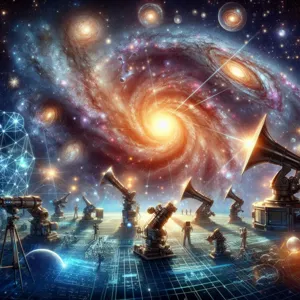The cosmos, with its mesmerizing tapestry of stars, planets, and galaxies, has long captivated humanity’s imagination.
As we gaze into the night sky, we might wonder: how do astronomers decipher the complex stories woven into the fabric of the universe? The journey of a galaxy—from its humble beginnings as a swirling cloud of gas and dust to its magnificent, sprawling form—is a tale of cosmic evolution filled with drama and intrigue. In this blog post, we will delve into the fascinating methods and innovative technologies that astronomers use to study galaxy formation and evolution. From powerful telescopes that capture distant light to sophisticated simulations that model cosmic interactions, we will unveil the tools and techniques that allow scientists to unravel the mysteries of the universe and deepen our understanding of the very galaxies that make up our night sky. Join us on this celestial adventure as we explore the dynamic processes that shape the galaxies we see today!
1. Introduction to Galaxy Evolution

The universe is a tapestry woven with countless galaxies, each with its own unique story and evolutionary path. Understanding galaxy evolution is akin to unveiling the intricate layers of a cosmic mystery, one that has fascinated astronomers for centuries. From the swirling spiral arms of a milky Way-like galaxy to the dense clusters of elliptical formations, the diversity of galaxies offers a window into the fundamental processes that govern the cosmos.
Galaxy evolution encompasses the birth, growth, and eventual fate of galaxies over vast timescales. It begins with the primordial clouds of gas and dust that, under the influence of gravity, coalesce to form the first stars and galaxies in the early universe. These initial formations then undergo a series of dynamic events, including mergers, interactions, and the complex interplay of dark matter and baryonic matter. As galaxies collide and merge, they not only reshape their structures but also trigger bursts of star formation and the creation of new celestial bodies.
Modern astronomers employ a multifaceted approach to study galaxy evolution, utilizing advanced telescopes and observational techniques that span the electromagnetic spectrum. These tools allow scientists to peer into the depths of space and time, capturing light from distant galaxies that have traveled for billions of years to reach us. By analyzing this light, astronomers can decipher the composition, motion, and activity surrounding these stellar systems.
In this blog post, we will delve deeper into the various stages of galaxy evolution, exploring the mechanisms behind their transformation, the role of dark matter, and the significance of cosmic structures in shaping the universe as we know it. Join us on this astronomical journey as we explore the evolution of galaxies and uncover the mysteries of our vast cosmos.
2. The Birth of Galaxies: Understanding Cosmic Origins
The Birth of Galaxies: Understanding Cosmic Origins
Galaxies are the majestic kingdoms of stars, dust, and dark matter that populate our universe, and their origins are as fascinating as they are complex. To unravel the mysteries of galaxy formation, astronomers delve into the depths of cosmic history, tracing back to the moments after the Big bang, approximately 13.8 billion years ago. In this primordial era, the universe was a hot, dense soup of particles. As it expanded and cooled, tiny fluctuations in density began to emerge, laying the groundwork for the structures we see today.
The process of galaxy formation is believed to be driven by gravitational forces. As matter clustered together, regions of higher density began to attract more gas and dust, leading to the gradual formation of the first galaxy seeds. These seeds, often referred to as protogalaxies, were relatively small and composed primarily of hydrogen and helium. Over millions of years, these nascent structures merged, grew, and evolved, eventually giving rise to the diverse array of galaxies we observe in the cosmos today.
Astronomers utilize advanced telescopes and cutting-edge technology to study the light emitted from distant galaxies, allowing them to glimpse the early universe and gather vital clues about how galaxies were born. By analyzing the spectral signatures of galaxies, they can determine their composition, age, and redshift—a phenomenon that reveals how fast they are moving away from us due to the universe’s expansion. This redshift data helps scientists estimate how far back in time they are observing, painting a vivid picture of galaxy evolution from its fiery inception to the present day.
Additionally, simulations and models play a crucial role in understanding galaxy formation. Researchers employ sophisticated computational techniques to recreate the conditions of the early universe, observing how dark matter halos interact with baryonic matter to form galaxies. These simulations help bridge the gap between theory and observation, providing a comprehensive understanding of how galaxies evolve over billions of years.
As we continue to probe the cosmos and gather more data, the story of galaxy birth unfolds like an epic saga, revealing not only the origins of celestial bodies but also the intricate dance of forces that shaped our universe. Understanding the birth of galaxies is more than just an academic pursuit; it is a journey into the very fabric of existence, offering profound insights into the nature of space, time, and our place within the cosmos.
3. Key Tools and Technologies Used in Astronomy

Astronomy has come a long way since the days of Galileo and his rudimentary telescopes, evolving into a high-tech field that employs an impressive array of tools and technologies to unlock the mysteries of the cosmos. These instruments are vital for studying galaxy evolution, allowing astronomers to peer deeper into space and time than ever before.
At the heart of modern astronomical research are ground-based and space-based telescopes. Ground-based observatories, like the Mauna Kea Observatories in Hawaii and the Very Large Telescope in Chile, are equipped with advanced adaptive optics systems that compensate for the Earth’s atmospheric turbulence, providing astronomers with clearer images of distant galaxies. Meanwhile, space telescopes, such as the Hubble Space Telescope and the recently launched James Webb Space Telescope, are free from atmospheric interference and can capture a broader spectrum of light, including ultraviolet and infrared. These capabilities enable astronomers to study the formation and evolution of galaxies in unprecedented detail.
In addition to telescopes, astronomers rely on spectrographs to analyze the light emitted or absorbed by celestial objects. By dispersing light into its component colors, these instruments reveal the chemical composition, temperature, and movement of galaxies. This information is crucial for understanding the processes that drive galaxy formation and evolution.
Radio telescopes also play a significant role in studying galaxies, particularly those shrouded in dust or located at great distances. By observing radio waves emitted by various celestial phenomena, such as pulsars and quasars, astronomers can gather insights into the behavior and interaction of galaxies across cosmic time.
Furthermore, advancements in computational technologies have revolutionized the field. Computer simulations and modeling allow researchers to visualize and predict the complex interactions between galaxies, dark matter, and the expanding universe. High-performance computing enables scientists to analyze vast amounts of data collected from different telescopes and space missions, helping them to piece together the puzzle of galaxy evolution.
Together, these key tools and technologies form a robust framework for astronomers, empowering them to explore the vastness of the universe and deepen our understanding of how galaxies evolve over billions of years. As instrumentation continues to advance, the future of astronomical research promises even more groundbreaking discoveries, bringing us closer to understanding the very fabric of our cosmos.
4. Observational Techniques: Telescopes and Beyond
Astronomy is a field that continually pushes the boundaries of human understanding, and at the forefront of this exploration are the observational techniques that astronomers employ to study galaxy evolution. Traditional optical telescopes have long been the stalwarts of astronomical research, capturing stunning images of celestial bodies and allowing scientists to piece together the history of our universe. However, the vastness of space and the complexity of galactic phenomena require a diverse toolkit of observational methods, extending far beyond just visual light.
One of the most revolutionary advancements in modern astronomy has been the development of radio telescopes. These instruments capture radio waves emitted by galaxies and their components, revealing insights into structures and processes that optical telescopes might miss. For instance, radio observations can detect cold gas clouds that are critical for star formation, helping astronomers understand how galaxies evolve over time.
In addition, infrared telescopes play a vital role in observing cooler objects in the universe. Many galaxies are shrouded in dust, which can obscure them in visible light. Infrared observations penetrate this dust, unveiling star-forming regions and providing a clearer picture of a galaxy’s composition and life cycle. Space-based telescopes, like the Hubble Space Telescope and the recently launched James Webb Space Telescope, have revolutionized our view of the cosmos by capturing high-resolution images and spectra across multiple wavelengths, enabling detailed studies of distant galaxies and their formation.
Moreover, X-ray and gamma-ray telescopes, such as the Chandra X-ray Observatory, target the high-energy processes occurring in the universe. These observations are crucial for understanding phenomena such as supermassive black holes and the energetic interactions within galaxy clusters. By combining data from these various observational techniques, astronomers can construct a comprehensive narrative of galaxy evolution, piecing together the lifecycle from star formation to the mergers and interactions that shape their development.
As technology continues to advance, new observational techniques, including gravitational wave astronomy, are emerging, promising to unlock even more secrets of the cosmos. By harnessing the power of these diverse tools, astronomers are not only studying the evolution of galaxies but also unraveling the very fabric of the universe itself, one observation at a time.
5. The Role of Spectroscopy in Studying Galaxies

Spectroscopy plays a pivotal role in the study of galaxies, serving as a powerful tool that allows astronomers to unlock the secrets of the cosmos. At its core, spectroscopy involves the analysis of light emitted or absorbed by celestial objects, breaking it down into its constituent wavelengths. This process reveals a wealth of information about a galaxy’s composition, temperature, density, and even its motion through space.
When astronomers observe a galaxy, they capture the light it emits, which contains unique fingerprints of various elements and molecules. By dispersing this light into a spectrum, researchers can identify the specific lines that correspond to different elements, like hydrogen, helium, or heavier metals. Each element absorbs and emits light at characteristic wavelengths, creating a spectral signature that acts like a cosmic barcode. This enables astronomers to determine not only what a galaxy is made of but also its chemical evolution over time.
Moreover, spectroscopy allows scientists to measure redshift—a phenomenon that occurs when light from an object is stretched as it moves away from us due to the expansion of the universe. This measurement is crucial for understanding the velocity at which a galaxy is receding, providing insights into cosmic expansion and the dynamics of galaxy clusters. By analyzing how the spectral lines shift, astronomers can calculate the speed and distance of galaxies, painting a clearer picture of the universe’s structure and evolution.
Additionally, spectroscopy can reveal the star formation rates within a galaxy by examining emission lines associated with young, hot stars. These lines indicate active regions where new stars are being born, helping researchers piece together the timeline of a galaxy’s development. By studying a galaxy’s spectrum over time, astronomers can trace its evolution and understand how it interacts with its environment, including mergers with other galaxies and the influence of dark matter.
In essence, spectroscopy acts as a cosmic lens that magnifies our understanding of galaxy evolution. Through this intricate dance of light and analysis, astronomers continue to unveil the mysteries of the universe, piecing together the grand narrative of galaxies as they form, evolve, and ultimately shape the cosmos as we know it.
6. Analyzing Light: Redshift and its Significance
When astronomers gaze into the vastness of the universe, they are not merely observing distant stars and galaxies; they are decoding the very history of the cosmos through the light that reaches us. One of the most pivotal concepts in this endeavor is redshift, an astronomical phenomenon that reveals crucial information about the universe’s expansion and the movement of celestial bodies.
Redshift occurs when the wavelength of light emitted by an object in space is stretched, making it appear more red than it would under normal circumstances. This shift can occur due to two primary factors: the Doppler effect and the expansion of space itself. In essence, when a galaxy is moving away from us, the light it emits is stretched, leading to a longer wavelength and a shift toward the red end of the spectrum. Conversely, if a galaxy is moving toward us, its light shifts to shorter wavelengths, appearing more blue. This simple yet profound observation allows astronomers to gauge not only the speed at which galaxies are receding from us but also their distance.
Understanding redshift is crucial for studying galaxy evolution. By measuring the redshift of various galaxies, astronomers can infer their velocities and, by extension, calculate how far back in time we are observing them. This is because light from distant galaxies takes billions of years to reach us, allowing us to glimpse the universe as it was in its infancy. By piecing together these observations, scientists can create a timeline of galaxy formation and evolution, revealing how galaxies have grown, merged, and transformed over cosmic time.
Moreover, redshift plays a vital role in the broader context of cosmology. It provides evidence for the Big Bang theory and the ongoing expansion of the universe. As astronomers examine the redshift of light from distant galaxies, they uncover insights into the rate of expansion and the overall structure of the cosmos. This knowledge not only deepens our understanding of how galaxies evolve but also raises profound questions about the fate of the universe itself.
In essence, analyzing light through the lens of redshift is a key tool for astronomers, allowing them to unravel the mysteries of galaxy evolution and the dynamic processes that have shaped the cosmos over billions of years. Through this lens, the universe unfolds its story, inviting us to explore the grand narrative of creation, transformation, and the endless dance of celestial bodies.
7. Simulations and Models: Recreating Cosmic Events

In the quest to understand galaxy evolution, astronomers turn to simulations and models that allow them to recreate the vast and intricate tapestry of cosmic events. Using powerful supercomputers, researchers develop complex algorithms that simulate the formation and growth of galaxies over billions of years. These simulations take into account a multitude of factors, including gravitational interactions, gas dynamics, and the effects of dark matter, allowing scientists to visualize how galaxies evolve in response to these cosmic forces.
Imagine peering into a digital universe where swirling clouds of gas coalesce under the influence of gravity, forming stars and eventually entire galaxies. This is the world of simulations, where astronomers can manipulate variables to see how changes in conditions might affect galaxy formation. For instance, by adjusting the amount of dark matter in their models, scientists can observe how it influences the clustering of galaxies and the rate of star formation.
One of the most exciting aspects of these simulations is their ability to mirror observations from telescopes, creating a feedback loop that enhances our understanding of the universe. When real-life data from cosmic surveys is compared to simulated outcomes, discrepancies can lead to new hypotheses about the underlying physics of galaxy formation. This iterative process helps refine existing models, pushing the boundaries of our knowledge and revealing the complexities of cosmic evolution.
Moreover, simulations provide a unique window into the past and future of the universe. By running simulations backward in time, astronomers can trace the history of a galaxy, exploring its formative years and the events that shaped its current structure. Conversely, forward-looking simulations can help predict the fate of galaxies, offering insights into phenomena such as galaxy collisions, mergers, and the ultimate destiny of the universe itself.
In essence, simulations and models are not just tools; they are vital components of modern astrophysics that enable astronomers to explore the cosmic narrative, unraveling the mysteries of galaxy evolution while bridging the gap between theory and observation. As technology continues to advance, the accuracy and detail of these simulations will only improve, promising even greater revelations about our universe’s grand design.
8. The Importance of Dark Matter in Galaxy Evolution
Dark matter, an elusive and mysterious component of the universe, plays a pivotal role in the evolution of galaxies. Although it cannot be seen directly—making up approximately 27% of the universe’s total mass-energy content—its gravitational effects are profound and far-reaching. For astronomers, understanding dark matter is akin to deciphering a cosmic puzzle, as its presence influences the formation, structure, and behavior of galaxies over billions of years.
When galaxies begin to form, they do so in regions of higher density within the cosmic web, where dark matter halos exist. These halos act as gravitational scaffolding, providing the necessary framework for ordinary matter to coalesce and form stars, gas, and dust. Without dark matter, the universe would look vastly different; galaxies may not have formed at all, or they would be significantly less massive and structured.
As galaxies evolve, dark matter continues to shape their destiny. Its gravitational pull affects how galaxies interact with one another, leading to phenomena such as mergers and collisions, which are crucial events in galaxy evolution. Astronomers study these interactions through simulations and observational data, seeking to understand how dark matter influences the dynamics of galaxies and their clustering in the universe.
Furthermore, the distribution of dark matter can provide insights into the history of a galaxy. By mapping the locations of dark matter through gravitational lensing—where light from distant objects is bent around massive dark matter structures—researchers can glean valuable information about the mass and distribution of galaxies throughout cosmic history.
In summary, dark matter is not just a mysterious entity lurking in the shadows of the cosmos; it is integral to the story of galaxy evolution. As astronomers unveil the complexities of dark matter, they are not only piecing together the history of galaxies but also deepening our understanding of the universe itself.
9. Understanding Stellar Populations and Their Life Cycles
Understanding stellar populations and their life cycles is a fundamental aspect of unraveling the intricate tapestry of galaxy evolution. Stars are the building blocks of galaxies, and their formation, life, and eventual death significantly influence the structure and dynamics of their host galaxies. Astronomers categorize stars into various populations based on their age, composition, and location within the galaxy, which provides crucial insights into the galaxy’s history and evolutionary path.
The two primary types of stellar populations are Population I and Population II stars. Population I stars, found predominantly in the spiral arms of galaxies, are young, metal-rich, and often form in clusters. They are the bright, hot stars that illuminate our night sky, playing a vital role in the ongoing processes of star formation and galactic evolution. On the other hand, Population II stars are older, metal-poor stars, typically located in the halo of galaxies or in globular clusters. Their existence hints at the early stages of galaxy formation, offering a glimpse into the primordial conditions of the universe.
As astronomers study these stellar populations, they track various stages of stellar life cycles, from birth in dense molecular clouds to the explosive deaths of massive stars in supernova events. Each phase of a star’s life contributes to the cosmic ecosystem; for instance, the death throes of a massive star can lead to the creation of neutron stars or black holes, while also enriching the surrounding interstellar medium with heavy elements—essential ingredients for future star and planet formation.
Sophisticated tools like spectrographs and space telescopes allow researchers to analyze the light emitted by stars, revealing their temperatures, compositions, and velocities. By observing the spectra of light from different stellar populations, astronomers can decipher the chemical makeup of stars and determine their ages, thereby constructing a timeline of galactic evolution.
This understanding of stellar populations not only sheds light on how galaxies grow and evolve over cosmic time but also helps explain the diversity of galaxies observed today. From the spiral arms of the Milky Way to the peculiar shapes of interacting galaxies, the life cycles of stars and their populations weave together to narrate the grand story of the universe—one that continues to unfold as astronomers unveil the cosmos.
10. The Role of Gas and Dust in Galaxy Formation
Gas and dust are the unsung heroes of galaxy formation, playing a crucial role in the intricate dance of cosmic evolution. These primordial materials, remnants of the universe’s early days, are not just passive observers; they are the very building blocks from which stars and galaxies arise. As astronomers delve into the depths of the cosmos, understanding the behavior and interactions of gas and dust becomes essential to unraveling the mysteries of how galaxies form and evolve over billions of years.
In the vast expanses of space, hydrogen and helium gas dominate, making up the majority of the universe’s baryonic matter. This gas is often found in vast clouds, which serve as the breeding grounds for new stars. Through the process of gravitational collapse, these clouds can condense and heat up, igniting nuclear fusion and birthing stars. However, this is just the beginning of the story. The dust particles, composed of heavier elements forged in the hearts of stars, play a pivotal role in cooling the gas and facilitating star formation. Without dust, the temperature of these clouds would remain too high for stars to coalesce effectively.
Furthermore, gas and dust are integral to the life cycles of galaxies. As stars age and die, they expel their outer layers, enriching the surrounding gas with metals and creating new generations of stars. This recycling of materials ensures that galaxies evolve over time, transitioning from young, star-forming regions to mature, diverse ecosystems of celestial bodies. Astronomers utilize sophisticated telescopes and instruments, such as the Atacama Large Millimeter/submillimeter Array (ALMA) and the James Webb Space Telescope, to observe these gas and dust interactions across different wavelengths. By studying the distribution, composition, and dynamics of these materials, scientists can piece together the evolutionary history of galaxies.
In summary, the interplay between gas and dust is fundamental to our understanding of galaxy formation. As we continue to explore the cosmos, these elements will remain central to the narrative of how galaxies, including our own Milky Way, evolve and thrive in the ever-expanding universe.
11. Mergers and Interactions: How Galaxies Evolve Over Time
Galaxies are not static entities; they are dynamic systems that evolve over cosmic timescales through a series of complex interactions and mergers. These processes are pivotal in shaping their structure, composition, and overall appearance. When two galaxies collide, the gravitational forces at play can lead to dramatic transformations. As they draw closer, their stellar and gaseous components begin to interact, triggering starbursts—periods of intense star formation that can outshine entire galaxies.
The aftermath of such mergers often results in the formation of new galaxy types, such as elliptical galaxies, which are typically more spherical and feature a smoother distribution of stars compared to their spiral counterparts. Conversely, interactions between galaxies can also lead to the creation of spectacular tidal tails—elongated streams of stars and gas that extend into space, illustrating the violent nature of these cosmic events.
Astronomers study these interactions using advanced telescopes equipped with both optical and radio capabilities, allowing them to observe the various stages of galaxy evolution. By analyzing the light emitted from galaxies, they can infer details about their masses, compositions, and distances. This information is further enhanced by computer simulations that model the physical processes involved in mergers and interactions, helping to predict future galaxy configurations and behaviors.
Moreover, observing galaxies at different distances allows astronomers to look back in time, piecing together the history of galaxy evolution across the universe. By examining how galaxies have interacted over billions of years, researchers can gain insights into the fundamental processes that govern cosmic structure formation. Ultimately, these studies not only deepen our understanding of individual galaxies but also enrich our comprehension of the universe’s evolution as a whole, revealing a complex tapestry of cosmic history woven through the interactions of galaxies.
12. The Influence of Supermassive Black Holes
Supermassive black holes (SMBHs) are titanic gravitational behemoths that lurk at the centers of most, if not all, massive galaxies. Their influence extends far beyond their immediate surroundings, shaping the very fabric of galaxy evolution in profound ways. Astronomers have long been fascinated by these enigmatic entities, and recent studies have revealed that they play a crucial role in regulating star formation and the growth of galaxies themselves.
As a galaxy forms and evolves, the SMBH at its core exerts a powerful gravitational pull, influencing nearby stars and gas. When matter spirals into a black hole, it forms an accretion disk, which can emit immense amounts of energy, often visible as bright quasars in distant galaxies. This process heats surrounding gas, leading to powerful outflows that can blow away material essential for star formation. In this way, the black hole can stifle the birth of new stars, effectively curbing the galaxy’s growth.
Moreover, the relationship between SMBHs and their host galaxies appears to be symbiotic. Observations suggest that the mass of an SMBH is tightly correlated with the mass of the galaxy’s bulge, hinting at a co-evolutionary process. This interdependence raises intriguing questions: do galaxies evolve to accommodate their black holes, or do the black holes shape their galaxies? By employing advanced telescopes and instruments, astronomers are piecing together this cosmic puzzle, utilizing techniques such as spectroscopy to measure the velocities of stars and gas near the black hole, revealing how it influences the galaxy’s dynamics.
As researchers continue to study these supermassive giants, we gain deeper insights into the life cycles of galaxies. The evolution of a galaxy is a dynamic interplay of gravitational forces and energetic phenomena, with SMBHs acting as key players in this celestial drama. Understanding their influence not only sheds light on the galaxies themselves but also provides a glimpse into the history and fate of the universe as a whole. In the grand tapestry of the cosmos, supermassive black holes emerge as both architects and destroyers, sculpting the galaxies we observe today.
13. Recent Discoveries in Galaxy Evolution Research
In the ever-expanding realm of astronomy, recent discoveries have significantly advanced our understanding of galaxy evolution, illuminating the intricate processes that shape the cosmos. One of the most groundbreaking findings comes from the James Webb Space Telescope (JWST), which has provided unprecedented views of galaxies formed in the early universe. With its ability to capture light from the most distant reaches of space, the JWST has unveiled galaxies that were previously thought to be mere theoretical constructs, revealing their structures, star formation rates, and chemical compositions.
In addition to the JWST’s contributions, astronomers have also utilized advanced computer simulations and machine learning algorithms to analyze vast datasets generated by ground-based telescopes. These innovative tools have allowed researchers to model the evolutionary pathways of galaxies more accurately, identifying key factors such as dark matter interactions and the role of supermassive black holes in galaxy formation. For example, studies have shown that supermassive black holes at the centers of galaxies can significantly influence star formation, either by promoting it through the release of energy or by quenching it through powerful jets and winds.
Moreover, recent observational campaigns have focused on understanding the importance of environment in galaxy evolution. The discovery of “galaxy groups” and “clusters” has shed light on how gravitational interactions between neighboring galaxies can lead to mergers, triggering bursts of star formation or even transforming galaxies into elliptical shapes as they collide and coalesce.
These discoveries not only enhance our knowledge of galaxy evolution but also raise new questions about the nature of dark energy and the ultimate fate of the universe. As astronomers continue to unravel the mysteries of the cosmos, each finding adds a vital piece to the puzzle, allowing us to appreciate the grandeur of the universe and our place within it.
14. Challenges and Limitations in Astronomical Research
The journey to unravel the mysteries of galaxy evolution is as awe-inspiring as the cosmos itself, yet it is fraught with challenges and limitations that astronomers must navigate. One of the primary hurdles is the sheer vastness of space. Galaxies are not only incredibly distant, often billions of light-years away, but they are also moving through an expanding universe. This means that observing them in real-time is akin to trying to capture a photograph of a moving target while blindfolded. The light we see has traveled vast distances, and what we observe may only be a snapshot of their past, complicating our understanding of their present state and evolutionary trajectory.
Moreover, the resolution of telescopes plays a critical role in astronomical research. While advancements in technology have led to the development of powerful instruments like the Hubble Space Telescope and the upcoming James Webb Space Telescope, even the best telescopes are limited by the laws of physics. Atmospheric interference, for instance, can distort images of celestial objects, making it challenging to gather precise data. Astronomers often have to use complex algorithms to correct these distortions, but this can introduce additional uncertainties.
Another significant challenge is the vast diversity of galaxies. Galaxies come in various shapes, sizes, and compositions, each with unique evolutionary histories influenced by factors such as gravitational interactions, star formation rates, and environmental conditions. This diversity complicates the creation of unified models of galaxy evolution. Researchers must often rely on statistical methods to make sense of large datasets, which can lead to oversimplifications or misinterpretations of the underlying processes at work.
Additionally, funding and access to the latest technology can be limiting factors in astronomical research. Many astronomers rely on grants and institutional support, which can vary significantly across regions and countries. This disparity can hinder collaboration and the sharing of knowledge, particularly in less-funded areas of research.
In summary, while the quest to understand galaxy evolution is filled with wonder and potential discoveries, it is not without its obstacles. Astronomers must continuously adapt to the limitations of their tools and methodologies, striving to piece together the cosmic puzzle amidst the vastness of the universe. Despite these challenges, their unwavering pursuit of knowledge continues to illuminate the dark corners of the cosmos, allowing us to glimpse the intricate tapestry of galactic evolution.
15. The Future of Galaxy Studies: Upcoming Missions and Technologies
The future of galaxy studies is poised on the brink of exciting advancements, with several upcoming missions and technologies set to revolutionize our understanding of galaxy evolution. As we look ahead, astronomers are gearing up for a new era of discovery that promises to unveil the cosmos in unprecedented detail.
One of the most anticipated missions is NASA’s James Webb Space Telescope (JWST), scheduled to launch in the near future. This state-of-the-art telescope is designed to observe the universe in infrared, allowing astronomers to peer through cosmic dust and gas that often obscure our view of distant galaxies. With its powerful instruments, JWST will be capable of studying the formation and evolution of galaxies across a wide range of cosmic epochs, from the early universe to the present day. Researchers expect that JWST will provide insights into the processes that lead to galaxy formation and the role of dark matter in shaping their structures.
In addition to JWST, the European Space Agency’s Euclid mission is set to explore the mysterious nature of dark energy and its influence on the expansion of the universe. By mapping the distribution of dark matter and observing the morphology of galaxies, Euclid aims to deepen our understanding of how galaxies evolve in the context of the cosmos. With its ability to capture millions of galaxies in a single sweep, this mission will generate an immense dataset that will keep astronomers busy for years to come.
Moreover, advancements in ground-based observatories are also on the horizon. The Extremely Large Telescope (ELT), currently under construction in the Atacama Desert of Chile, will be the world’s largest optical telescope. With its advanced adaptive optics system, the ELT will provide stunningly detailed images of galaxies, enabling researchers to study their formation and interactions with unparalleled clarity. Such observations will enhance our understanding of galaxy mergers, star formation, and the intricate dance of gravitational forces at play in the universe.
Finally, the integration of artificial intelligence and machine learning is set to revolutionize how astronomers analyze vast amounts of data generated by these new missions. By employing sophisticated algorithms, researchers can identify patterns and anomalies in galaxy formations that were previously undetectable. This technological leap will streamline the discovery process, allowing scientists to focus on the most intriguing questions about galaxy evolution.
As we stand on the cusp of these groundbreaking missions and technologies, the future of galaxy studies looks incredibly promising. With each new discovery, we inch closer to unlocking the secrets of the universe and understanding the intricate tapestry of galaxies that adorn the night sky. The cosmos has many stories to tell, and soon, we will have the tools to listen.
As we conclude our exploration of how astronomers study galaxy evolution, it’s clear that the cosmos holds a wealth of mysteries waiting to be unveiled. From the intricate dance of dark matter to the breathtaking formation of stars and the interplay of cosmic forces, each discovery brings us closer to understanding the universe we inhabit. The innovative techniques and technologies employed by astronomers today allow us to peer deeper into the past, revealing the narratives of galaxies over billions of years. As we continue to advance our knowledge and refine our tools, the future of galactic studies promises even more exciting revelations. We invite you to stay curious, keep gazing at the stars, and join us in celebrating the ongoing quest to unlock the secrets of the universe. Your journey into the cosmos has only just begun!






